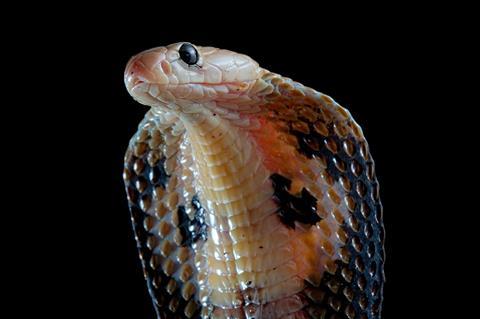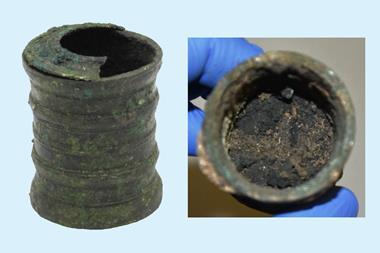Accidental death, or a murder carried out with venom?

A particular person might be referred to as cold blooded, but ectothermic species truly embody the term. Spring and summer mean leaping lizards, frolicking fish and slithering snakes as warmer environments boost an ectotherm’s energy and activity. Just when many people are excitedly outdoors for sun and fun, so are snakes. Increased human–snake encounters may mean more snakebites.
According to the World Health Organization, of the 5.4 million people worldwide bitten by snakes annually, up to half are envenomed, resulting in approximately 81,000–138,000 deaths and ‘around three times as many amputations and other permanent disabilities’. Of the animal venoms, snake venom is one of the best characterised, with composition varying within and between species.1,2
The majority of a snake venom’s components are peptides and proteins with neurotoxic, haemotoxic and cytotoxic bioactivities that can endow a snake ’with a chemical weapon far more potent than physical force’.2
Snake venom’s harmful potential has not translated to snake-as-lethal-weapon with anywhere near the frequency of other weapons. The vast majority of snakebites are accidental.3–5 Historical tales of snakes being used to self-harm or harm others – such as Cleopatra’s death-by-cobra or Carthaginian general Hannibal catapulting pots of venomous snakes at an enemy – seem more myth than fact.6–7 In the scientific literature, only a pair of homicide-by-snakebite cases have been reported.
In 2012, a team of doctors with the Government Medical College’s Department of Forensic Medicine in Maharashtra State, India reported on what they believed was the ‘first case reported where a snake was directly used for the murder of two victims through a contract killer’.8
The two victims were husband and wife, who were kidnapped and subjected to an assault by a common cobra – a poisonous snake frequently found in rural areas of India. When death was declared at a hospital shortly after the assault, it was supposed to look like an unfortunate accident.
Toxicological options were limited, so no venom was extracted from postmortem samples. However, autopsy and histopathological findings – congestion and swelling of visceral organs, with the kidneys also showing hemorrhage and scarring – indicated the death of the couple was due to envenomation.
Bite marks were found on the right forearm of the husband and right hand of the wife. These bite locations struck a discordant note. The majority of accidental snakebites are localised to the lower limbs and likely result from humans literally encountering snakes underfoot.
An investigation revealed the couple’s son hired a contract killer who, in turn, involved additional accomplices – including a cobra charmer – to kill the couple over a property dispute.
Location clues
Another family tragedy features in reportedly the only other homicidal snakebite orchestrated to look like an accident, as reported in 2016 by a team from Egypt’s Forensic Medicine and Clinical Toxicology Department at Minia University and the Egyptian Forensic Medicine Authority.9
A father alerted authorities that he found all three of his daughters – aged 4, 6 and 9 – deceased one morning. Possible bite marks were observed on the lower limbs of all three during autopsy. As in the previous homicide case, venom detection via toxicological techniques was not available, though pathological examinations pointed to envenomation.
While the bite locations could support an accident, the location of the home did not – ‘a flat in an urban area where snakes are rare’. An investigation revealed all three children were killed by their father because he ‘decided to get rid of his girl children’. After training to become a snake charmer and purchasing an Egyptian cobra, he carried out his plan.
While intense investigations revealed this set of suspicious snakebite cases to be homicides rather than accidents, an accidental snake bite fatality case in Florida, US, is one of the first to use proteomic analysis to confirm snake envenomation.10
The owner and breeder of a timber rattlesnake (C. horridus) was found deceased with injuries to his right hand and head consistent with being bitten, then falling – perhaps more than once – from standing height. Autopsy findings supported an accidental death, with cause of death being envenomation by C. horridus.
Blood samples were collected during autopsy and processed for serum proteomic analysis via liquid chromatography–tandem mass spectrometry (LC–MS/MS) along with standard commercial human plasma. With the assistance of a standard multiple species protein database search tool, approximately 50 C. horridus proteins were identified in the decedent’s heart and chest serum. Such screening was made more straightforward as the species of snake was known.
Researchers conducting this work noted that not all of the detected C. horridus proteins were from venom, noting that other snake proteins could have been introduced into the wound during the bite. This work expands the ability to verify the envenomation – something that is critical to accidental and intentional snakebite investigations.
References
1C A Dawson et al, PLOS Negl. Trop. Dis., 2024, 18, e0012570 (DOI: 10.1371/journal.pntd.001257)
2 A L Oliveira et al, Nat. Rev. Chem., 2022, 6, 451 (DOI: 10.1038/s41570-022-00393-7)
3 D K Wasko and S G Bullard, Wild. Environ. Med., 2016, 27, 219 (DOI: 10.1016/j.wem.2016.01.004)
4 J D Jaramillo et al, Trauma Surg. Acute Care Open, 2019, 4, e000374 (DOI: 10.1136/tsaco-2019-000374)
5 L Chen and G-z Huang, Forensic Sci. Int., 2013, 232, e12 (DOI: 10.1016/j.forsciint.2013.08.013)
6 G Tsoucalas and M Sgantzos, The Death of Cleopatra: Suicide by Snakebite or Poisoned by Her Enemies? In Toxicology in Antiquity, Academic Press, 2019, p83
7 A Burton, Front. Ecol. Environ., 2021, 19, 196 (DOI: 10.1002/fee.2332)
8 V N Ambade et al, Med. Sci. Law, 2012, 52, 40 (DOI: 10.1258/msl.2011.011020)
9 M G Paulis and A L Faheem, J. Forensic Sci., 2016, 61, 559 (DOI: 10.1111/1556-4029.12997)
10 T Gallagher et al, J. Forensic Sci., 2023, 68, 711 (DOI: 10.1111/1556-4029.15213)

















No comments yet